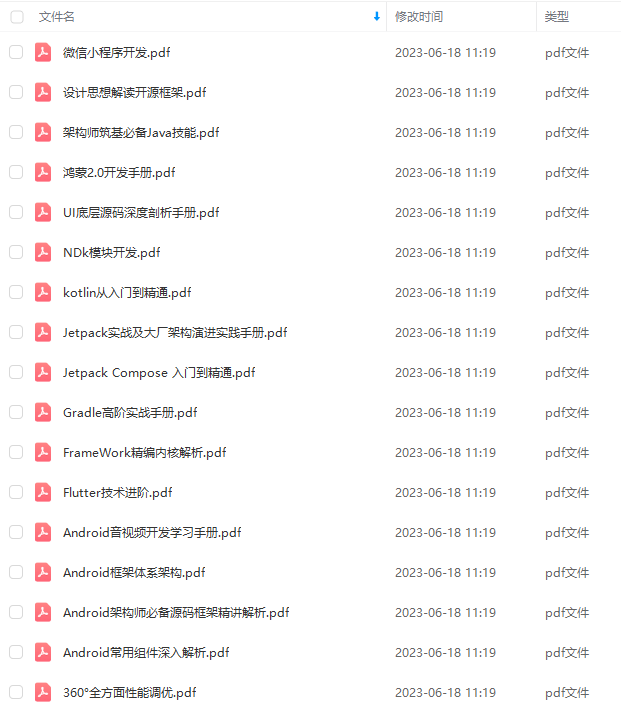notifyRendererOfFramePending();
pokeDrawLockIfNeeded();
}
}
而这个mTraversalRunnable就是我们所要执行的任务了,那究竟是何时执行呢?
首先会mChoreographer.postCallback会间接调用postCallbackDelayedInternal方法
private void postCallbackDelayedInternal(int callbackType,
Object action, Object token, long delayMillis) {
if (DEBUG_FRAMES) {
Log.d(TAG, “PostCallback: type=” + callbackType
-
“, action=” + action + “, token=” + token
-
“, delayMillis=” + delayMillis);
}
synchronized (mLock) {
final long now = SystemClock.uptimeMillis();
final long dueTime = now + delayMillis;
mCallbackQueues[callbackType].addCallbackLocked(dueTime, action, token);
if (dueTime <= now) {
scheduleFrameLocked(now);
} else {
Message msg = mHandler.obtainMessage(MSG_DO_SCHEDULE_CALLBACK, action);
msg.arg1 = callbackType;
msg.setAsynchronous(true);
mHandler.sendMessageAtTime(msg, dueTime);
}
}
}
我们可以看到正常情况下会执行scheduleFrameLocked方法
private void scheduleFrameLocked(long now) {
if (!mFrameScheduled) {
mFrameScheduled = true;
if (USE_VSYNC) {
if (DEBUG_FRAMES) {
Log.d(TAG, “Scheduling next frame on vsync.”);
}
// If running on the Looper thread, then schedule the vsync immediately,
// otherwise post a message to schedule the vsync from the UI thread
// as soon as possible.
if (isRunningOnLooperThreadLocked()) {
scheduleVsyncLocked();
} else {
Message msg = mHandler.obtainMessage(MSG_DO_SCHEDULE_VSYNC);
msg.setAsynchronous(true);
mHandler.sendMessageAtFrontOfQueue(msg);
}
} else {
final long nextFrameTime = Math.max(
mLastFrameTimeNanos / TimeUtils.NANOS_PER_MS + sFrameDelay, now);
if (DEBUG_FRAMES) {
Log.d(TAG, “Scheduling next frame in " + (nextFrameTime - now) + " ms.”);
}
Message msg = mHandler.obtainMessage(MSG_DO_FRAME);
msg.setAsynchronous(true);
mHandler.sendMessageAtTime(msg, nextFrameTime);
}
}
}
由于在4.1上是使用VSYNC信号的,所以就自然会调用scheduleVsyncLocked方法,会间接调用scheduleVsync方法
**
-
Schedules a single vertical sync pulse to be delivered when the next
-
display frame begins.
*/
public void scheduleVsync() {
if (mReceiverPtr == 0) {
Log.w(TAG, "Attempted to schedule a vertical sync pulse but the display event "
- “receiver has already been disposed.”);
} else {
nativeScheduleVsync(mReceiverPtr);
}
}
注意:这里的注释说的很清楚了,当下一帧来临时准备一个要分发的垂直同步信号,啥意思呢?简单来说就是当调用了nativeScheduleVsync方法时,当屏幕需要刷新的时候,也就是每隔16.6ms会通过native的looper分发到java层,从而调用java的方法,那是哪个方法呢?
// Called from native code.
@SuppressWarnings(“unused”)
private void dispatchVsync(long timestampNanos, int builtInDisplayId, int frame) {
onVsync(timestampNanos, builtInDisplayId, frame);
}
很明显是此方法
举个例子,比如屏幕显示的是第一帧,你在第一帧调用invalidate,其实并不是立即刷新的,而是在一帧会去注册一个Vsync(前提是这一帧cpu空闲情况下),当下一帧来临时也就是第二帧的时候会调用dispatchVsync此方法,当然这是一种比较简单的情况,复杂的等会说
那么来看一下调用的onVsync方法
public void onVsync(long timestampNanos, int builtInDisplayId, int frame) {
// Ignore vsync from secondary display.
// This can be problematic because the call to scheduleVsync() is a one-shot.
// We need to ensure that we will still receive the vsync from the primary
// display which is the one we really care about. Ideally we should schedule
// vsync for a particular display.
// At this time Surface Flinger won’t send us vsyncs for secondary displays
// but that could change in the future so let’s log a message to help us remember
// that we need to fix this.
if (builtInDisplayId != SurfaceControl.BUILT_IN_DISPLAY_ID_MAIN) {
Log.d(TAG, "Received vsync from secondary display, but we don’t support "
-
"this case yet. Choreographer needs a way to explicitly request "
-
"vsync for a specific display to ensure it doesn’t lose track "
-
“of its scheduled vsync.”);
scheduleVsync();
return;
}
// Post the vsync event to the Handler.
// The idea is to prevent incoming vsync events from completely starving
// the message queue. If there are no messages in the queue with timestamps
// earlier than the frame time, then the vsync event will be processed immediately.
// Otherwise, messages that predate the vsync event will be handled first.
long now = System.nanoTime();
if (timestampNanos > now) {
Log.w(TAG, "Frame time is " + ((timestampNanos - now) * 0.000001f)
-
" ms in the future! Check that graphics HAL is generating vsync "
-
“timestamps using the correct timebase.”);
timestampNanos = now;
}
if (mHavePendingVsync) {
Log.w(TAG, "Already have a pending vsync event. There should only be "
- “one at a time.”);
} else {
mHavePendingVsync = true;
}
mTimestampNanos = timestampNanos;
mFrame = frame;
Message msg = Message.obtain(mHandler, this);
msg.setAsynchronous(true);
mHandler.sendMessageAtTime(msg, timestampNanos / TimeUtils.NANOS_PER_MS);
}
注意看下timestampNanos的参数(简单来说就是从调用native方法以后到回调到这个方法所经过的的时间)
接着看会发送一条异步消息,简单来说就是此消息在消息队列中不用排队,可以最先被取出来,很明显,会调用下面的run方法进行处
@Override
public void run() {
mHavePendingVsync = false;
doFrame(mTimestampNanos, mFrame);
}
这里调用的doframe方法
void doFrame(long frameTimeNanos, int frame) {
final long startNanos;
synchronized (mLock) {
if (!mFrameScheduled) {
return; // no work to do
}
if (DEBUG_JANK && mDebugPrintNextFrameTimeDelta) {
mDebugPrintNextFrameTimeDelta = false;
Log.d(TAG, "Frame time delta: "
- ((frameTimeNanos - mLastFrameTimeNanos) * 0.000001f) + " ms");
}
long intendedFrameTimeNanos = frameTimeNanos;
startNanos = System.nanoTime();
final long jitterNanos = startNanos - frameTimeNanos;
if (jitterNanos >= mFrameIntervalNanos) {
final long skippedFrames = jitterNanos / mFrameIntervalNanos;
if (skippedFrames >= SKIPPED_FRAME_WARNING_LIMIT) {
Log.i(TAG, "Skipped " + skippedFrames + " frames! "
- “The application may be doing too much work on its main thread.”);
}
final long lastFrameOffset = jitterNanos % mFrameIntervalNanos;
if (DEBUG_JANK) {
Log.d(TAG, "Missed vsync by " + (jitterNanos * 0.000001f) + " ms "
-
"which is more than the frame interval of "
-
(mFrameIntervalNanos * 0.000001f) + " ms! "
-
"Skipping " + skippedFrames + " frames and setting frame "
-
“time to " + (lastFrameOffset * 0.000001f) + " ms in the past.”);
}
frameTimeNanos = startNanos - lastFrameOffset;
}
if (frameTimeNanos < mLastFrameTimeNanos) {
if (DEBUG_JANK) {
Log.d(TAG, "Frame time appears to be going backwards. May be due to a "
- “previously skipped frame. Waiting for next vsync.”);
}
scheduleVsyncLocked();
return;
}
if (mFPSDivisor > 1) {
long timeSinceVsync = frameTimeNanos - mLastFrameTimeNanos;
if (timeSinceVsync < (mFrameIntervalNanos * mFPSDivisor) && timeSinceVsync > 0) {
scheduleVsyncLocked();
return;
}
}
mFrameInfo.setVsync(intendedFrameTimeNanos, frameTimeNanos);
mFrameScheduled = false;
mLastFrameTimeNanos = frameTimeNanos;
}
try {
Trace.traceBegin(Trace.TRACE_TAG_VIEW, “Choreographer#doFrame”);
AnimationUtils.lockAnimationClock(frameTimeNanos / TimeUtils.NANOS_PER_MS);
mFrameInfo.markInputHandlingStart();
doCallbacks(Choreographer.CALLBACK_INPUT, frameTimeNanos);
mFrameInfo.markAnimationsStart();
doCallbacks(Choreographer.CALLBACK_ANIMATION, frameTimeNanos);
mFrameInfo.markPerformTraversalsStart();
doCallbacks(Choreographer.CALLBACK_TRAVERSAL, frameTimeNanos);
doCallbacks(Choreographer.CALLBACK_COMMIT, frameTimeNanos);
} finally {
AnimationUtils.unlockAnimationClock();
Trace.traceEnd(Trace.TRACE_TAG_VIEW);
}
if (DEBUG_FRAMES) {
final long endNanos = System.nanoTime();
Log.d(TAG, "Frame " + frame + ": Finished, took "
-
(endNanos - startNanos) * 0.000001f + " ms, latency "
-
(startNanos - frameTimeNanos) * 0.000001f + " ms.");
自我介绍一下,小编13年上海交大毕业,曾经在小公司待过,也去过华为、OPPO等大厂,18年进入阿里一直到现在。
深知大多数初中级安卓工程师,想要提升技能,往往是自己摸索成长,但自己不成体系的自学效果低效又漫长,而且极易碰到天花板技术停滞不前!
因此收集整理了一份《2024年最新Android移动开发全套学习资料》送给大家,初衷也很简单,就是希望能够帮助到想自学提升又不知道该从何学起的朋友,同时减轻大家的负担。




由于文件比较大,这里只是将部分目录截图出来,每个节点里面都包含大厂面经、学习笔记、源码讲义、实战项目、讲解视频
如果你觉得这些内容对你有帮助,可以添加下面V无偿领取!(备注Android)

学习分享
在当下这个信息共享的时代,很多资源都可以在网络上找到,只取决于你愿不愿意找或是找的方法对不对了
很多朋友不是没有资料,大多都是有几十上百个G,但是杂乱无章,不知道怎么看从哪看起,甚至是看后就忘
如果大家觉得自己在网上找的资料非常杂乱、不成体系的话,我也分享一套给大家,比较系统,我平常自己也会经常研读。

七大模块学习资料:如NDK模块开发、Android框架体系架构…

只有系统,有方向的学习,才能在段时间内迅速提高自己的技术。
这份体系学习笔记,适应人群:
第一,学习知识比较碎片化,没有合理的学习路线与进阶方向。
第二,开发几年,不知道如何进阶更进一步,比较迷茫。
第三,到了合适的年纪,后续不知道该如何发展,转型管理,还是加强技术研究。如果你有需要,我这里恰好有为什么,不来领取!说不定能改变你现在的状态呢!
网络上找到,只取决于你愿不愿意找或是找的方法对不对了
很多朋友不是没有资料,大多都是有几十上百个G,但是杂乱无章,不知道怎么看从哪看起,甚至是看后就忘
如果大家觉得自己在网上找的资料非常杂乱、不成体系的话,我也分享一套给大家,比较系统,我平常自己也会经常研读。
[外链图片转存中…(img-UXM3f6kt-1711385592958)]
七大模块学习资料:如NDK模块开发、Android框架体系架构…
[外链图片转存中…(img-7eCehFyD-1711385592959)]
只有系统,有方向的学习,才能在段时间内迅速提高自己的技术。
这份体系学习笔记,适应人群:
第一,学习知识比较碎片化,没有合理的学习路线与进阶方向。
第二,开发几年,不知道如何进阶更进一步,比较迷茫。
第三,到了合适的年纪,后续不知道该如何发展,转型管理,还是加强技术研究。如果你有需要,我这里恰好有为什么,不来领取!说不定能改变你现在的状态呢!
由于文章内容比较多,篇幅不允许,部分未展示内容以截图方式展示 。如有需要获取完整的资料文档的朋友点击我的GitHub免费获取。






















 1万+
1万+











 被折叠的 条评论
为什么被折叠?
被折叠的 条评论
为什么被折叠?








